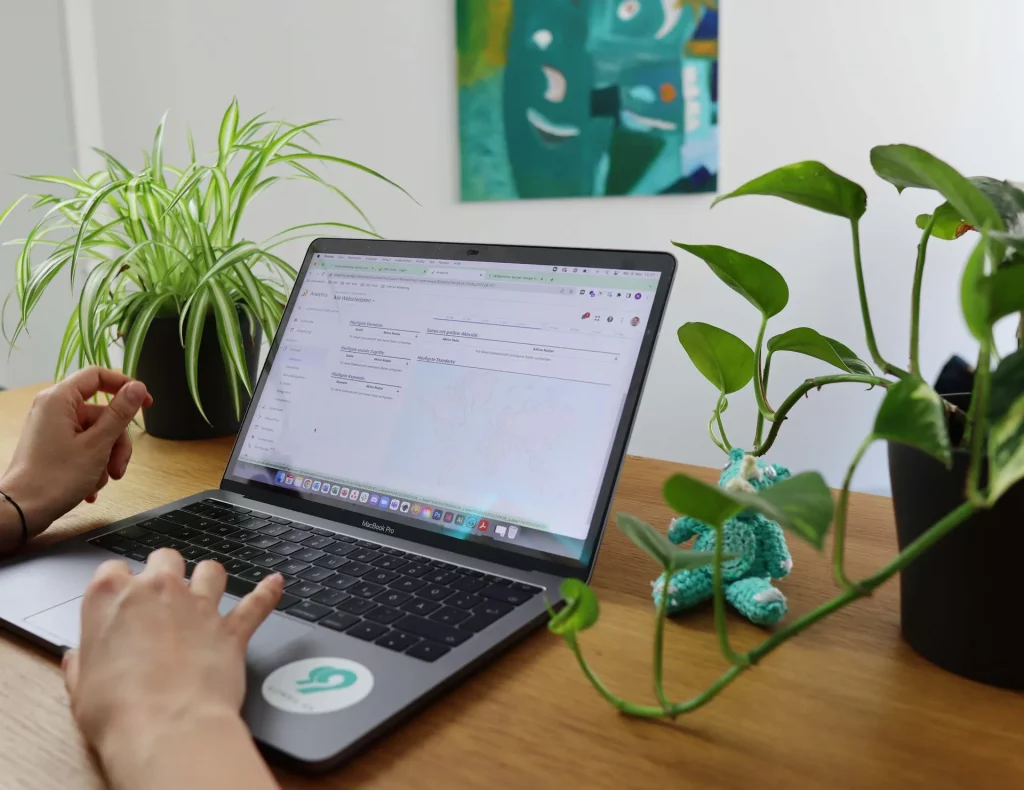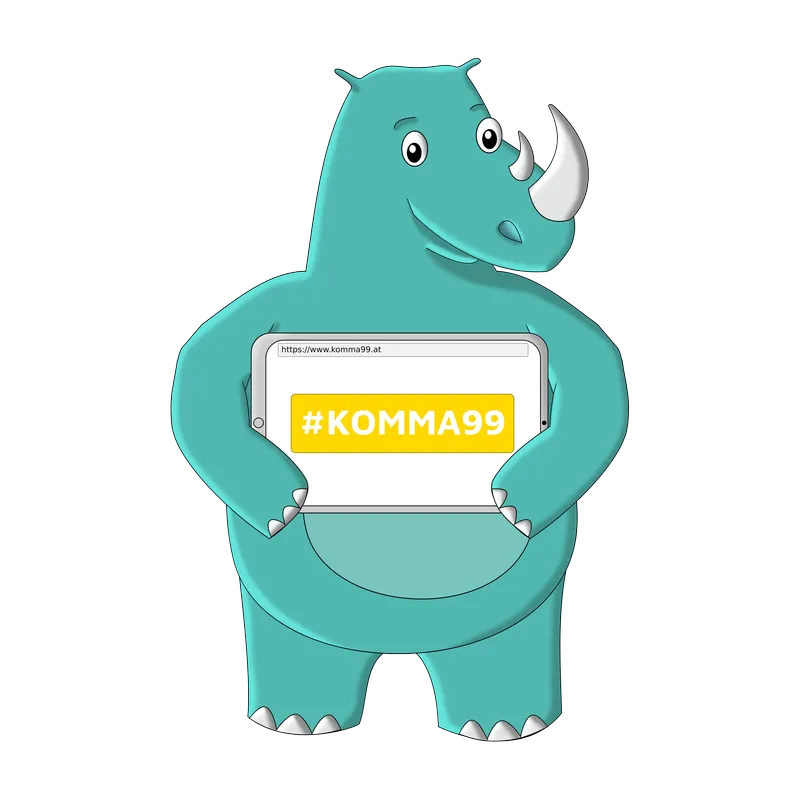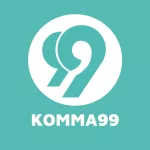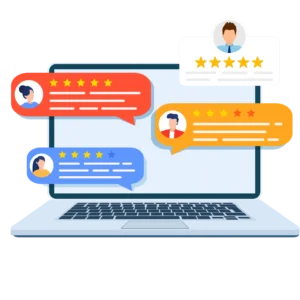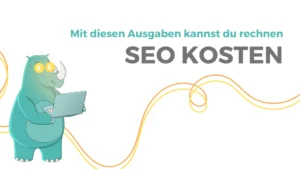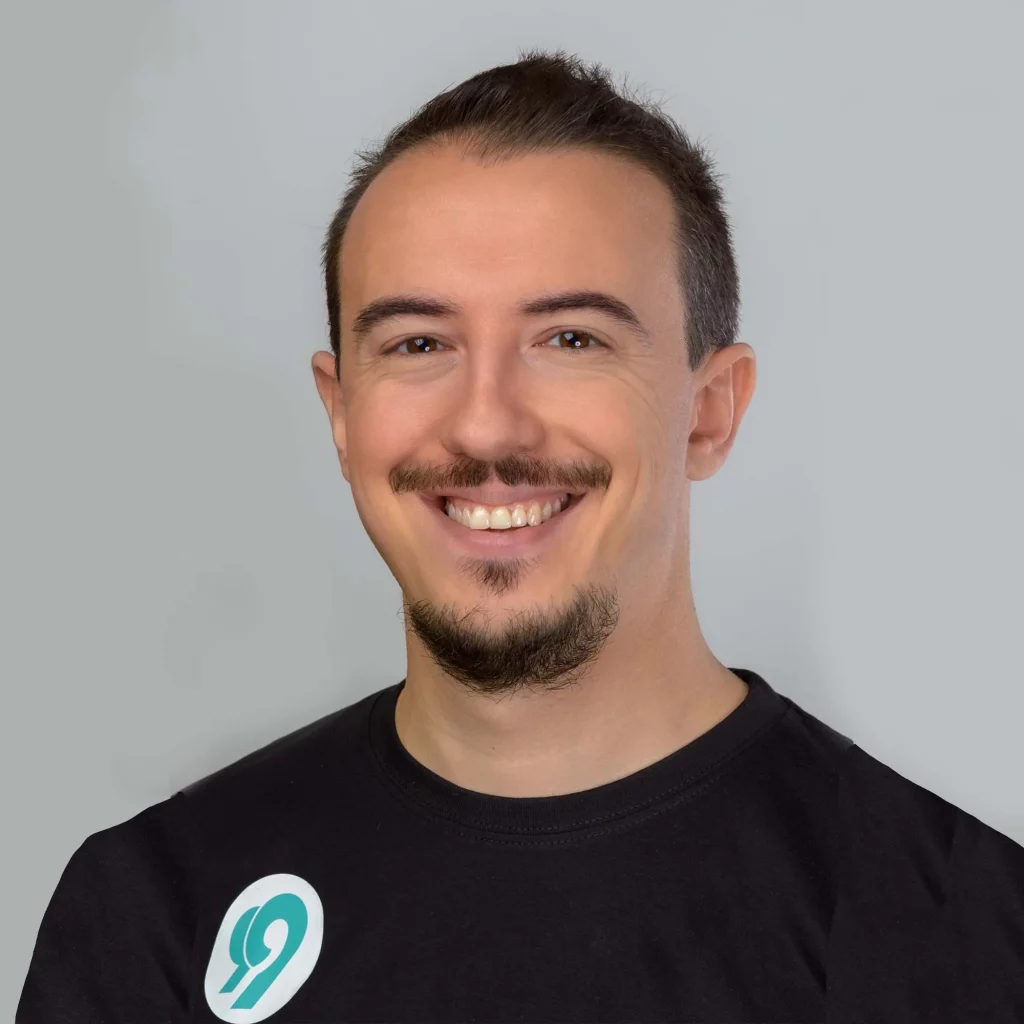Search engine optimization (SEO) simply explained and tips for SEO in 2023
If you've ever wondered what SEO actually is, why it's becoming more and more relevant, and what's in store for SEO in 2023, you're in for a treat. will count - then you're in the right place!
In this article you will learn what SEO is all about, why SEO is no longer a hype, but rather a Must-Have talk and what you need to pay attention to in 2023 to do good and sustainable search engine optimization.
What is SEO?
In the past, we used to browse through the phone book in search of service providers - today, we dig through online search engines. Although... we don't dig that far, because most of us already make our decision on the first page. That's why in SEO circles it's called:
"What's the best place to hide a secret? Google page 2."
Because no one will ever find it there. When companies present their services and products they do not want to hide from their customers, then SEO comes into play.
Search Engine Optimization Search engine optimization (SEO) is the process of optimizing websites and online stores for search engines.. Simply put: good SEO makes websites and online stores more attractive for certain terms (keywords) position on the first search results page. Why is SEO so useful? If a website is positioned on the first page of Google, the probability that users will actually find it is much higher. The goal of SEO is therefore: better rankings, more traffic, more inquiries and more sales.
Why SEO?
Now you might be thinking: If companies offer their services or products on their website, then they will be found by their target group in search engines like Google. Unfortunately, it's not that simple.
What used to work (many, many years ago) with link farms and hidden content (e.g. white writing on a white background) definitely no longer works today. Search engines like Google expect a certain pinch of ingenuity, because after all, it is also the goal of search engines to give their users the best result in each case present. Search engine optimization is therefore no longer as easy as it might have been in the past. Exactly this is why SEO is needed - companies that want to be positioned at the top of the search terms (keywords) relevant to them in the long term, can't avoid SEO.
How does SEO work?
First things first: SEO doesn't happen overnight. Search engine optimization is a part of online marketing that should be viewed in the long term. If you want to optimize a website for search engines like Google, you should plan enough time to achieve your goals - regardless of whether you do it yourself or through an SEO agency. The SEO measures include many different sub-areas: The optimization of technology and content (content), the structure of Backlinks with other websites and also optimization of usability and User Experience. After all, users should be happy with the search result, because that is the main goal of search engines like Google.
On the one hand, of course, it takes time to implement all these optimizations, on the other hand, search engines like Google also need time to recognize these optimizations. So if you want to be positioned at the top for a certain search term (keyword) and write an excellent SEO text that makes both search engines and users happy, it does not mean that the website will be top positioned shortly thereafter.
Since it is advisable to think SEO long-term therefore also one Long-term SEO strategy is an advantage. SEO agencies usually plan SEO projects from 6 months to several years - this can increase the visibility of websites in the long term.
Onpage and Offpage SEO - What's the difference?
If you do search engine optimization, you optimize websites for search engines such as Google. This means that links to other websites (Backlinks) are built, that the technology of the website is fine is implemented and that the content corresponding to the expectations is suitably prepared. All of these points can be roughly divided into two sub-areas: Onpage and Offpage SEO.
-
Onpage SEO
All measures that can be implemented directly on the website are referred to as on-page SEO. The optimization therefore takes place on the page, as the name "Onpage-SEO" already suggests. On the one hand, this includes the Technology such as page speed optimization or the correction of 404 error pages. In addition to the technology, a major focus of on-page optimization is also on the Content of the website - this includes the text, the headings, title, meta description and images SEO (alt text). In order to round off the combination of technology and content, two more points are needed that must be taken into account with on-page SEO: usability and User Experience. User expectations must be met, so the usability of the website must be simple and logical. With a good balance between text, structure and design, the user experience can be positively influenced.
-
Offpage SEO
As Offpage-SEO the building of qualitative links with other websites designated. In contrast to on-page SEO, off-page optimization is not concerned with optimizing your own website, but with linking to other websites. You can think of the World Wide Web as a spider web – websites are networked with each other. The more a website is linked to other quality websites, the better, as this signals search engines such as Google that a site is relevant and trustworthy. Quality plays a major role here. Simply collecting links via link farms no longer works today, backlinks must be built up naturally and steadily. The most common options for off-page optimization are (company) directories, links via guest articles or networking with Partner and customer websites.
The aim of SEO
When companies spend money on SEO, they want one thing through the measures: More inquiries and more sales through their website. But that is not the primary goal of SEO. The goal of SEO is to position websites and online shops for specific search terms (keywords) on the first search results page. Or rather, on the first positions of the first page.
Good to knowThe first position receives an average of 21% clicks, the second position receives an average of 10% of clicks, and the tenth position (the last position on the first page) receives just under 1.5%. This shows: Not only page 1 should be the goal of SEO, but position 1. |
The fact that good positions in search engines such as Google result in more inquiries and more sales depends on many different optimization factors. First and foremost, the users expectations must be met, because only then are the searchers willing to buy. This means that the content must be perfectly tailored to the target group and that the usability of the page (usability) should be simple and understandable. The eye eats with you - not only when eating but also when it comes to Web design. The design should run like a red thread through the entire website and prepare the content in a beautiful design. With the factors usability, user experience and qualitative content the first step has been taken to turn interested users into buying customers.
How to do SEO?
If you do search engine optimization, you optimize websites for search engines such as Google. This means that links to other websites (backlinks) so that the technology of the website is finely implemented and that the content corresponding to the expectations are suitably prepared in the course of the measures. Sound easy? With the necessary know-how it is. Nevertheless, SEO takes a lot of time - depending on the keyword, the goal of number 1 in Google can be achieved in a few weeks or even several years. In the next few points you will find out what keywords actually are and which ranking factors really count.
What are keywords?
The search terms that users enter into Google searches are displayed as Keywords. A keyword, by definition, is a search term, buzzword or keyword - a term that users search for. For SEO experts, there is not just one type of keyword, there are many different subcategories. Here are the two most important:
- Short Tail Keywords: Short tail keywords are search terms that contain a maximum of 3 words. For example: "buy sneakers".
- Long Tail Keywords: Long tail keywords are search terms that contain more than 3 words. For example: "buy blue sneaker herren".
An important feature of keywords is the search intention, it provides information about the expectations of users. Do users want to buy something? Do you just want to find information? Are you undecided? To answer these questions, SEOs distinguish between:
- Transaction-oriented keywords: Transactional Keywords: Behind these keywords there is a clear intention to buy, which means that users are specifically looking for services or products. As in our previous example: “buy sneakers”. Only performance pages (pages with an offer) can rank for these types of search terms.
- Information-oriented keywords: With these types of search terms, users don't want to buy anything, they want to find information. For example: “eiffel tower height”. Only informative pages (blog articles or guides) can rank for these types of search terms.
This distinction is very important in keyword research, because the decision is already made here as to which target pages are necessary and important for optimization.
Now you know that keywords vary in length and that search intent plays a big role. What is also very important is the search volume. Because only the search volume shows whether a keyword makes sense. Keyword tools such as KWFinder or Ubersuggest can be used to find out how often a keyword is searched for on average per month per country. If you come to the conclusion that a search term that you actually thought was very relevant is not being searched for at all - then you should get rid of this keyword. Because if nobody is looking for it, the SEO goals will not be able to be achieved either.

The higher the search volume, the more difficult it is usually to optimize a website for this term. Why? A hotly contested keyword does not belong to you alone, there are also many industry-specific competitors on it. This means: The smaller the search volume, the faster a good ranking in search engines such as Google can be achieved. The higher the search volume, the longer the search engine optimization for this term will take.
The most important SEO ranking factors
The most important SEO ranking factors are:
Technology
Proper technique is the basis of search engine optimization. A website must have the technical SEO basics in order to be able to operate sustainable search engine optimization. SEO techniques include:
- Fast loading time: The loading time of a website should be less than 3 seconds.
-
- Sitemap: The sitemap is the directory in which all pages of a website are created and facilitates the crawling process of search engines.
- Optimized URL structure: The URL structure and page navigation should be simple and logical.
- GDPR & Security: Websites must be GDPR compliant and secure.
- Mobile Optimization: Websites are also accessed by mobile devices, so an optimized mobile version must be available.
Content
Content is one of the most important aspects of search engine optimization. Search engines crawl the content of websites and decide, among other things, on the basis of the content whether websites are well positioned. Good content means: high quality, useful and tailored to the respective search term.
Keyword focus
The main goal of search engine optimization is to find websites for specific search terms position well within search engines. These search terms are referred to by us SEOs as Keywords. If you do search engine optimization, you need a keyword focus - because only then does SEO make sense. Of course, you can focus on several keywords with a website, but the general rule is: one landing page for each keyword. The following must be implemented on the respective target page:
- Keywords is included in the title
- Keyword is included in the meta description
- Keyword is contained in the H1 (main heading).
- Keyword is contained in the subheadings (H2 – H6)
- Keyword is included in the file name of the inserted images and in the alt text
- Bonus: Keyword is included in the URL
User signals (Nutzersignale)
When we talk about user signals, we are referring to the signals that users send us within the interaction with websites. These include:
- Click through rate: The click through rate is the rate of clicks on the search results page. The click rate can be positively influenced with an optimized SERP snippet, consisting of title and meta description.
- Dwell time: The dwell time describes the length of time a user stays on a website.
- Bounce rate: The bounce rate tells us how many of the website visitors leave the website immediately.
The last two user signals, length of stay and bounce rate, can be optimized through content design and optimization in usability and user experience.
Links
Links are internal links, external links and also backlinks.
- Internal links: Internal links are links that are set within a website to your own website. Example: I link to the contact page from the start page with a “contact button”, so this link is called an internal link. The better your website is linked internally, the easier it is for users to navigate the site and quickly find what they are looking for.
- External links: External links are links that are set within a website to another website. Example: I link to another page within a blog post, for example to give a source, so this link is called an external link.
- Backlinks: The construction of backlinks is referred to as off-page SEO in search engine optimization. A backlink is a link from one website to another website. The more qualitative backlinks are built, the stronger your own website will be. Good backlink sources are company and trade directories, links on the websites of partners and customers and links to websites relevant to the industry (e.g. through guest contributions).
Search Engine Optimization (SEO) in 2023
Search engines like Google are always evolving. If you aim to optimize websites and online stores for search engines, it is important to always stay on the ball. Compared to 2022 and the years before, the measures change for Search Engine Optimization 2023 not completely. Basically, the essential core elements remain the same, but the focus and relevance of the individual optimization areas is likely to be concretized. Doing search engine optimization (SEO) in 2023 means spending a lot of time in to invest in qualitative and high-quality content, to prepare the content in a target group-oriented manner (content design) and, through authority and trustworthiness convince. Of course, in addition to all these things, the technical basics must also fit, but that is a basic requirement for SEO anyway. The next points give you an overview of what will be important for SEO 2023:
Qualitative content
As an SEO agency, we often hear questions like "How long is an SEO text?" or “Just put in the keyword a few times and then we’re on page 1, right?” - it's not that easy. The algorithms of search engines like Google are constantly evolving, what worked well last year may not work at all today. The fact that a website must have quality content in order to achieve a good ranking in search engines such as Google is actually obvious. How do you create quality content? In addition to the typical SEO text features such as a correct heading hierarchy and content tailored to the respective focused keyword ( WDF*IDF) the following points must also be considered in order to create really good SEO content:
- Correct Information: All content must be accurate and truthful, Research is therefore an important part of content creation.
- Emphasize benefits: Why do searchers find what they are looking for on your website? The maximum benefit must be recognizable for your target group, otherwise they will quickly leave the site again.
- Emphasize benefits: Why do searchers find what they are looking for on your website? The maximum benefit must be recognizable for your target group, otherwise they will quickly leave the site again.
- Attention to detail: Don't just pay attention to the text, but to the entire content. Content also means photos, infographics, videos or other design elements. A continuous text alone will not convince your target group, a well thought-out structure will.
Content Design
With the last point, we have already given a hot tip on what will still matter for SEO in 2023: Content Design. The key to SEO success lies not only in content that is perfectly tailored to the target group, but also to a large extent in content design. Only if the content is packaged in a target group-oriented design, a good reading flow can be ensured. Our tips for your content measures:
- Complement the text with photos, graphics, tables, videos, etc .
- Brighten up the text with lists (like here 🙂 ).
- Write strong headlines that will get website visitors stuck.
- Give your target group possibilities for interaction (newsletter registration, contact)
- Note the red thread in the design that runs through the entire website should pull.
Google E-A-T
No, this isn't about food. Google's EAT stands for Expertise - Authority - Trustworthiness. In order to achieve good rankings in the Google search engine, it is therefore important that your site is trustworthy and recommended How to convey authority and trustworthiness? In order to rank well in terms of E-A-T by Google, one should take care of off-page SEO. Specifically, it is about the backlink profile of a website. Backlinks are links to other websites and can be viewed as recommendations. It is important to get backlinks from quality websites - it is the quality that counts, not the quantity! Our recommendations for quality backlinks:
- Links from your customers: Ask your happy customers if they would link to your website on their website.
- Links from your partners: Do you regularly work with partners? This is a great way to generate a backlink.
- Links about guest posts: Are you an expert in your field? Write guest articles in blogs or on other websites and generate strong backlinks.
- Links via directories: Probably the easiest way to generate links is to enter them in company and trade directories.
Building quality backlinks is usually a give and take – offer therefore also encourage your partners and customers to link them to your website. There is another advantage for customers in particular: they can give a positive rating for your company in the form of a testimonial and are thus integrated and linked to your website.
Technical SEO basics
If the basic technical requirements of a website are not right, then the best content SEO is useless. Therefore, make sure that these technical SEO basics are met on your website.
- Fast loading time: A website should take a maximum (!) 1-2 seconds to be displayed completely. The faster the better. You can check the loading time with the Google Pagespeed Insights or GTMetrix.
- Mobile Only: What used to be Mobile First is now Mobile Only. Optimize your website for mobile devices, because that is where the future lies. If your website is not accessible in the mobile version, search engines like Google could even exclude it from indexing.
- GDPR & Security: Make sure your website is GDPR compliant and secure. In addition to the HTTPS certificate, this also includes the correct handling of analytical data. If you are unsure whether your website is GDPR-compliant, We'd be happy to check that for you.
- Accessibility of the pages: Every page that is indexed - i.e. can be found in the Google search engine - should also be accessible and have content. If a page cannot be reached, it is called a 404 error. If searchers find no content on the page, they will quickly leave it again. Therefore, such 404 pages must be redirected to accessible pages.
- Core Web Vitals : The Core Web Vitals include the usability of Web pages. In search engine optimization, user-friendliness is becoming more and more relevant - after all, search engines want to suggest the best result for users. Ease of use includes speed, visual stability, and logical interaction.
Conclusion: Search Engine Optimization (SEO) in 2023
Search engine optimization does not change fundamentally in 2023. What will change, or rather intensify, is the focus on content quality, added value for users and trustworthiness of the website. If you take care to create high-quality content that actually offers added value and meets the expectations of users, you have already made a big step in search engine optimization 2023. If you also keep the necessary technical SEO basics and the networking with other websites in mind, the probability is high that the optimization will bear fruit and search engines like Google will position your website well.

